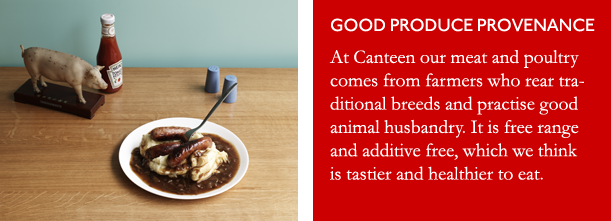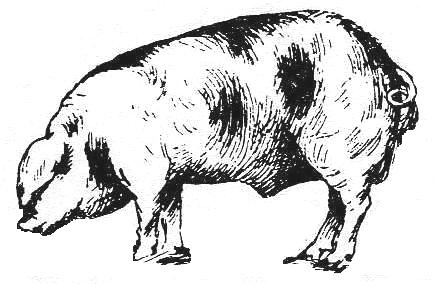A Review of Great British Food from Canteen, & Pig: King of the Southern Table by James Villas
Two new books to buy
Two noteworthy books have just appeared in print. It is fitting to review them in this number of britishfoodinamerica, for one of them covers traditional British food in a contemporary context and the other covers charcuterie in the American south. Both of them are handsome editions and their publishers, the Ebury Press in London and John Wiley in Hoboken, New Jersey, deserve congratulation.
Great British Food (Seasonal British All-Day Dining on its back cover) by Patrick Clayton-Malone, Dominic Lake and Cass Titcombe of Canteen in London is the more visually stylish of the two. It is bound in brown bag or cardboard colored cloth and bears the authors and title in the sans serif typeface that conjures interwar Britain and the London Underground; a clean, recognizable design.
Canteen is a miniglomerate of interrelated businesses that include a commercial art studio, furniture designer and chain of restaurants that utilizes both of the other enterprises to create its look. Their book is heavy on promotion of the business and looks at first like a glossy arts publication, doubtless the authors’ intent. The pious tone of its discussion about the British culinary tradition and the illustrator’s clumsy irony--the text is interladen with food porn enlivened by spooky, funny taxidermy (but we have seen this sort of thing before) -- make the book nearly irritating and yet not quite so bad. The Canteeners may be forgiven, both because of the spare and elegant design of their restaurants, and because on balance the book itself is a wry and elegant production.

The Canteen group has engaged in a sophisticated branding effort and it has worked: Three Canteens in London have joined the original Spitalfields restaurant. Their look is the look of their book, sleek evocations of a grittier tradition. The authors immodestly assert that “Canteen is often described as a stylish cross between a British transport café and a diner” (Great British Food 14) and the description is not bad. They explain that the restaurants offer old style ‘caf’ standards, “[b]ut ours are the best of the best and we hope you will try our recipes.” (Great British Recipes 14) This promotional preening grates (What has happened to the endearing British virtue of modesty?) but is not unjustified.
We are pleased to note that according to Canteen’s writers, “[p]ies are our true signature dishes--we have made it our mission to resurrect our country’s honourable tradition of savoury pastries” and cannot wait to try the duck, chestnut and prune version after the weather turns. We are, however, disappointed that Canteen has not given credit to Elisabeth Ayrton for their obvious paraphrase of The Cookery of England, in which she devotes a chapter to “The Tradition of the Savoury Pie.”
Canteen has not published a pathbreaking cookbook. Instead, Great British Food offers its readers what amounts to a primer on traditional British preparations. There are no postmodern attempts at innovation or evolution.
There are, however, Scotch eggs and sausage rolls, potted foods and those beautiful pies, a series of roasts and instructions for bread sauce (essential for roast chicken or duck), soused fish and coronation chicken. Canteen promises to be “unapologetically nostalgic when it comes to our desserts and cakes. We truly believe that it’s hard to beat treacle tart with clotted cream, crumble with custard, or home-made jelly and ice cream, especially with shortbread fingers.” (Great British Food 14) We could not agree more.
All of these recipes, both savory and sweet, are appealing and they work. Great British Food protests a bit much on its own behalf, but then the authors show, and keep, some promise too. Their book is an entertaining, handsome and instructive introduction to British foodways for those unaware of Elisabeth Ayrton, Lizzie Boyd or Jane Grigson.
Pig: King of the Southern Table by James Villas is something altogether different. It is his seventeenth book and demonstrably his best. Not that Villas’ prior efforts are bad; it is just that he has raised his own bar and written something that should join the dozen or so texts central to the southern culinary canon.
The intent and design of Pig could not veer farther from Great British Cooking. If the Canteen group has made an attempt at high concept art, then Pig is all homely vernacular. The aim is accessibility over cleverness, the format big and open rather than ironic and knowing. Rather than extolling himself in the informative text that accompanies his recipes, Villas celebrates the foodways of the south. He is generous; unlike the people from Canteen, Villas has drenched his recipes in attribution, giving thanks to Damon Lee Fowler, Edna Lewis, Bill Neal, Paul Prudhomme, John Thorne and many, many others. Villas exudes generosity and banishes authorial insecurity. His exuberant style propelled the Editor to light the stove and get Pig all splattery with pork fat.
Pig is not flawless. Its food porn insets are unnecessary and will look dated. The index is awful. Villas can sound silly and tries too hard to regionalize his dishes, but that is a sign of our times. Otherwise he is neither self-indulgent nor guilty of padding; there are but two bogs, one an excellent recipe enhanced with shrimp, because he already has an entire book about them and the burgoos and stews of the south. Otherwise Villas has not missed much. There is, of course, plenty of barbecue, and there are lots of ways with ham along with instructions for hoecakes, jambalaya, pulled pork, spoonbread, succotash and the other staples of the south.
But wait, there is more. Villas has sprinkled Pig with delightful asides: “There are seven different varieties of hickory wood for Southern barbecue....” (Pig 303) He has teased out the secret of pickled pork, otherwise unknown outside Louisiana. Rarities abound; examples include hobotee (a derivation of South African bobotie and previously unfamiliar to the Editor), sidemeat, souse, ham potato bread, and biscuits of ham and grits.

Villas also gives the British culinary tradition, and its exemplary impact on the American south, full faith and at least some credit. He explains, for example, that “the tradition of potting numerous meats and seafood with butter in the South can be traced to our English heritage” and includes a sweet-tart pork, apple and raisin pie that “harks back to colonial days.” It would be at home in the pages of Gervase Markham or Robert May. (Pig 3, 148) There are other pies too and that souse, along with devils, and an insane version of angels (or devils) on horseback that dusts sausage with sage and wraps it in bacon to induce porked-up delerium.
France is not much in evidence here, but dishes splashed with sherry (and all-American Madiera) or glazed in chutney, and a recipe for sausage with onion and apple gravy, will be familiar in concept to writers and readers of Great British Food and of course britishfoodinamerica.
Go get a copy of Pig and prepare to spend a lot of happy hours in your kitchen.

